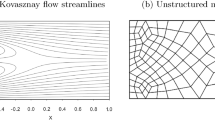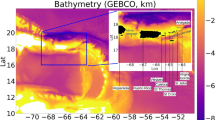Abstract
This paper considers the formation of the thermohaline structure of the Arctic Ocean: the formation of the salinity field and a freshwater reservoir in the Beaufort Sea and the transport of warm Atlantic water into the central part of the Arctic Ocean. A new version of the Finite Element Model of the Arctic Ocean (FEMAO) with a low spatial resolution is used. The main distinctions of this version are the following features: a new equation of state, a more sophisticated parameterization of vertical turbulence, modified formulations for the boundary conditions on open boundaries (using satellite data on the sea level) and at the upper boundary of the ocean, and the use of a variable eddy diffusivity in the parameterization of the eddy transport of a scalar. Our experiments indicated that the use of the parameterization of the eddy transport of a scalar enhances the transport of warm Atlantic waters to the central part of the Arctic Ocean through the Fram Strait; the results are most realistic when a variable coefficient is used. The Neptune effect has a contradictory role and, in the future, a higher spatial resolution should be used instead of this parameterization. We revealed that a key factor in the thermohaline fields on a large time scale is the interaction with the Atlantic Ocean, which is the source of heat and saline water.
Similar content being viewed by others
References
A. Proshutinsky, M. Steele, J. Zhang, et al., “Multinational Effort Studies Differences among Arctic Ocean Models,” EOS 82(51), 637–644 (2001).
P. Uotila, D. M. Holland, M. A. Morales Maqueda, et al., “An Energy-Diagnostics Intercomparison of Coupled Ice-Ocean Arctic Models,” Ocean Model. 11(1–2), 1–27 (2006).
I. M. Belkin, S. Levitus, J. Antonov, et al., “Great Salinity Anomalies in the North Atlantic,” Prog. Oceanogr. 41(1), 1–68 (1998).
I. A. Shiklomanov, A. I. Shiklomanov, R. B. Lammers, et al., “The Dynamics of River Water Inflow to the Arctic Ocean,” in Fresh Water Budget of the Arctic Ocean, Ed. by E. L. Lewis, (Kluwer Acad, Norwell, MA, 2000), pp. 281–296.
A. Proshutinsky, R. H. Bourke, and F. A. McLaughlin, “The Role of the Beaufort Gyre in the Arctic Climate Variability: Seasonal to Decadal Climate Scales,” Gephys. Res. Lett 29(23), 2100 (2002). Doi: 10.1029/2002GL015847
I. V. Polyakov, A. Y. Proshutinsky, and M. A. Johnson, “Seasonal Cycles in Two Regimes of Arctic Climate,” J. Geophys. Res. 104(C11), 25761–25788 (1999).
S. Haakkinen, “An Arctic Source for the Great Salinity Anomaly: A Simulation of the Arctic Ice-Ocean System for 1955–1975,” J. Geophys. Res. 98(C9), 16397–16410 (1993).
S. Haakkinen and A. Proshutinsky, “Freshwater Content Variability in the Arctic Ocean,” J. Geophys. Res. 109, C03051 (2004). Doi: 10.1029/2003JC001940
M. Steele, W. Ermold, S. Hakkinen, et al., “Adrift in the Beaufort Gyre: A Model Intercomparison,” Geophys. Res. Lett. 28(15), 2935–2938 (2001).
G. Holloway, F. Dupont, E. Golubeva, et al., “Water Properties and Circulation in Arctic Ocean Models,” J. Geophys. Res. 112, 03 (2007). Doi: 10.1029/2006JC003642
N. G. Yakovlev, “Reproduction of the Large-Scale State of Water and Sea Ice in the Arctic Ocean in 1948–2002: Part I. Numerical Model,” Izv. Atmos. Ocean. Phys. 45(3), 357–371 (2009).
N. G. Yakovlev, “Reproduction of the Large-Scale State of Water and Sea Ice in the Arctic Ocean from 1948 to 2002: Part II. The State of Ice and Snow Cover,” Izv. Atmos. Ocean. Phys. 45(4), 478–494 (2009).
C. L. Parkinson and W. M. Washington, “A Large-Scale Numerical Model of Sea Ice,” J. Geophys. Res. 84(C1), 311–337 (1979).
W. D. Hibler Iii, “Modeling a Variable Thickness Sea Ice Cover,” Mon. Wea. Rev. 108(9), 1943–1973 (1980).
G. M. Flato and W. D. Hibler Iii, “Ridging and Stress in Modeling the Thickness Distribution of Arctic Sea Ice,” J. Geophys. Res. 100(C9), 18611–18626 (1995).
E. C. Hunke and J. K. Dukowicz, “An Elastic-Viscous-Plastic Model for Sea Ice Dynamics,” J. Phys. Oceanogr. 27(9), 1849–1867 (1997).
E. C. Hunke, “Viscous-Plastic Sea Ice Dynamics in the EVP Model: Linearization Issues,” J. Comput. Phys. 170(1), 18–38 (2001).
N. A. Dyanskii, V. Ya. Galin, A. V. Gusev, et al., “The Model of the Earth System Developed at the INM RAS,” Russ. J. Numer. Anal. Math. Modelling 25(5), 419–429 (2010).
O. C. Zienkiewicz and R. L. Taylor, The Finite Element Method, 5th. ed, Vol. 3: Fluid Dymanics (Butterworth and Heinemann, Oxford, 2000).
D. Brydon, S. Sun, and R. Bleck, “A New Approximation of the Equation of State for Seawater, Suitable for Numerical Ocean Models,” J. Geophys. Res. 104(C1), 1537–1540 (1999).
D. R. Jackett, T. J. McDougall, R. Feistel, et al., “Algorithms for Density, Potential Temperature, Conservative Temperature, and Freezing Temperature of Seawater,” J. Atmos. Ocean. Technol. 23(12), 1709–1728 (2006).
G. I. Marchuk, V. P. Kochergin, V. I. Klimok, et al., “Mathematical Modeling of Surface Turbulence in the Ocean,” Izv. Akad. Nauk SSSR, Fiz. Atmos. Okeana 12(8), 841–849 (1976).
V. P. Kochergin, “Three-Dimensional Prognostic Models,” in Three-Dimensional Coastal Ocean Models, Ed. by N. Heaps, AGU Coast. Estuar. Sci. 4, 201–208 (1987).
I. V. Polyakov, “Diagnostic Computations of the Arctic Ocean Currents and Sea Level Variations,” Izv. Atmos. Ocean. Phys. 32(5), 637–649 (1996).
Z. Kowalik and I. Polaykov, “Diurnal Tides Over Kashevarov Bank, Okhotsk Sea,” J. Geophys. Res. 104(C3), 5361–5380 (1999).
H. Goosse, Development of a Global Coupled Sea-Ice Ocean Model, Progress Report 1995, Louvain-la-Neuve: Institut d’Astronomie et de G?ophysique G. Lemátre, 1995), vol. 5.
L. H. Kantha and C. A. Clayson, “An Improved Mixed Layer Model for Geophysical Applications,” J. Geophys. Res. 99(C12), 25235–25266 (1994).
G. L. Mellor and T. Yamada, “Development of a Turbulence Closure Model for Geophysical Fluid Problems,” Rev. Geophys. Spac. Phys. 20(4), 851–875 (1982).
P. D. Craig and M. L. Banner, “Modeling Wave-Enhanced Turbulence in the Ocean Surface Layer,” J. Phys. Oceanogr. 24(12), 2546–2559 (1994).
R. A. Flather, “A Tidal Model of the Northwest European Continental Shelf,” Memories de la Societe Royale des Sciences de Liege 6(10), 141–164 (1976).
J. Proudman, “The Effect of Coastal Friction on the Tides,” Mon. Not. Roy. Astron. Soc. Geophys. 5(1), 23–26.
V. M. Kamenkovich, Foundations of the Ocean Dynamics (Gidrometeoizdat, Leningrad, 1973).
R. X. Huang, “Real Freshwater Flux as a Natural Boundary Condition for the Salinity Balance and Thermohaline Circulation Forced by Evaporation and Precipitation,” J. Phys. Oceanogr. 23(11), 2428–2446 (1993).
M. Prange and R. Gerdes, “The Role of Surface Freshwater Flux Boundary Conditions in Arctic Ocean Modelling,” Ocean Model. 13(1), 25–43 (2006).
P. R. Gent and J. C. McWilliams, “Isopycnal Mixing in Ocean Circulation Models,” J. Phys. Oceanogr. 20(1), 150–155 (1990).
R. C. Pacanowski and S. M. Griffies, The MOM3 Manual (NOAA, Geophysical Fluid Dynamics Laboratory, 1999).
M. Visbeck, J. Marshall, T. Haine, et al., “Specification of Eddy Transfer Coefficients in Coarse Resolution Ocean Circulation Models,” J. Phys. Oceanogr. 27(3), 381–402 (1997).
G. Holloway, “Representing Topographic Stress for Large-Scale Ocean Models,” J. Phys. Oceanogr. 22(9), 1033–1046 (1992).
E. Kazantsev, J. Sommeria, and J. Verron, “Subgrid-Scale Eddy Parameterization by Statistical Mechanics in a Barotropic Ocean Model,” J. Phys. Oceanogr. 28(6), 1017–1042 (1998).
I. Polyakov, “An Eddy Parameterization Based on Maximum Entropy Production with Application to Modeling of the Arctic Ocean Circulation,” J. Phys. Oceanogr. 31(8), 2255–2270 (2001).
M. Steele, R. Morley, and W. Ermold, “PHC: A Global Ocean Hydrography with a High Quality Arctic Ocean,” J. Clim. 14(9), 2079–2087 (2001).
O. M. Pokrovsky and L. A. Timokhov, “The Reconstruction of the Winter Fields of Water Temperature and Salinity in the Arctic Ocean,” Oceanology 42(6), 822–830 (2002).
A. Proshutinsky, R. Krishfield, M. -L. Timmermans, et al., “The Beaufort Gyre Fresh Water Reservoir: State and Variability from Observations,” J. Geophys. Res. 114, A10 (2009). Doi: 10.1029/2008JC005104.
Author information
Authors and Affiliations
Corresponding author
Additional information
Original Russian Text © N.G. Iakovlev, 2012, published in Izvestiya AN. Fizika Atmosfery i Okeana, 2012, Vol. 48, No. 1, pp. 100–116.
Rights and permissions
About this article
Cite this article
Iakovlev, N.G. On the simulation of temperature and salinity fields in the Arctic Ocean. Izv. Atmos. Ocean. Phys. 48, 86–101 (2012). https://doi.org/10.1134/S0001433812010136
Received:
Published:
Issue Date:
DOI: https://doi.org/10.1134/S0001433812010136




